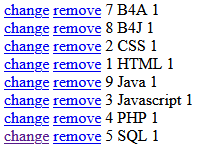<?php
// category.php
class category {
public $id;
public $name;
public $active;
public function __construct($id="",$name="",$active="") {
$numargs = func_num_args();
if ($numargs == 1) {
$rec = func_get_arg(0);
$this->id = $rec['id'];
$this->name = $rec['name'];
$this->active = $rec['active'];
} else {
$this->id = $id;
$this->name = $name;
$this->active = $active;
}
}
public function add($db) {
try {
$sql = "INSERT INTO category";
$sql .= " (id,name,active)";
$sql .= " VALUES (:id,:name,:active);";
$values = array(':id'=>null,':name'=>$this->name,':active'=>$this->active);
$result = $db->query_prepared($sql,$values);
return $result;
}
catch(PDOException $e)
{
return "error";
}
}
public function change($db) {
try {
$sql = "UPDATE category";
$sql .= " SET id=:id,name=:name,active=:active";
$sql .= " WHERE id=:id;";
$values = array(':id'=>$this->id,':name'=>$this->name,':active'=>$this->active);
$result = $db->query_prepared($sql,$values);
return $result;
}
catch(PDOException $e)
{
return "error";
}
}
public function remove($db) {
try {
$sql = "DELETE FROM category";
$sql .= " WHERE id=:id;";
$values = array(':id'=>$this->id);
$result = $db->query_prepared($sql,$values);
return $result;
}
catch(PDOException $e)
{
return "error";
}
}
public function count_records($db) {
$sql = "SELECT COUNT(id) FROM category";
$result = $db->select_query($sql);
$rs = $result->fetch();
return $rs[0];
}
public function all_records($db) {
$list = [];
$sql = "SELECT * FROM category order by name";
$result = $db->select_query($sql);
foreach($result->fetchAll() as $rec) {
$list[] = new category($rec);
}
return $list;
}
public function all_active_records($db) {
$list = [];
$sql = "SELECT * FROM category WHERE active = 1 order by name";
$result = $db->select_query($sql);
foreach($result->fetchAll() as $rec) {
$list[] = new category($rec);
}
return $list;
}
public function all_records_sorted_and_paging($db,$sort,$start_record,$records_per_page) {
$list = [];
$sql = "SELECT * FROM category ORDER BY :sort LIMIT :start_record,:records_per_page";
$values = array(':sort'=>$sort,':start_record'=>$start_record,':records_per_page'=>$records_per_page);
$result = $db->query_prepared($sql,$values);
foreach($result->fetchAll() as $rec) {
$list[] = new category($rec);
}
return $list;
}
public function search($id,$db) {
$sql = "SELECT * FROM category WHERE id = :id";
$id = intval($id);
$values = array(':id'=>$id);
$result = $db->query_prepared($sql,$values);
$rec = $result->fetch();
return new category($rec);
}
}
// make a list using the category table class and the database class
require("database.php");
if (!isset($db)) $db = new database();
require "category.php";
$catobj = new category();
$categories = $catobj->all_active_records($db);
foreach($categories as $objcat) {
// category_form.php will use the record id for changing or removing the record
echo "<a href='category_form.php?id=".$objcat->id."&action=change'>change</a> ";
echo "<a href='category_form.php?id=".$objcat->id."&action=remove'>remove</a> ";
echo $objcat->id . " " . $objcat->name . " " . $objcat->active . "<br>";
}

<!doctype html>
<html>
<head>
<meta name='viewport' content='width=device-width,initial-scale=1,maximum-scale=1'>
<link rel='stylesheet' type='text/css' href='w3.css'>
</head>
<body>
<?php
require("database.php");
if (!isset($db)) $db = new database();
require "category.php";
$catobj = new category();
$action = "add";
$id = "";
if (isset($_GET['id']) && isset($_GET['action'])) {
$category = $catobj->search(htmlspecialchars($_GET['id']),$db);
$action = htmlspecialchars($_GET['action']);
$id = htmlspecialchars($_GET['id']);
}
?>
<table><tr><td style="vertical-align:top;">
<form class='w3-container' action='category_process.php' method='POST'>
<div class='w3-container' style='' id=''>
<h3>Admin category</h3>
<label class='w3-label w3-text-teal'><b>name *</b></label>
<input class='w3-input w3-border w3-light-grey' type='text' name='name'
value='<?php if (isset($category)) echo $category->name; ?>' required /><br>
<label class='w3-label w3-text-teal'><b>active *</b></label>
<input class='w3-input w3-border w3-light-grey' type='text' name='active'
value='<?php if (isset($category)) echo $category->active; ?>' required />
<label class='w3-left w3-text-teal'><b>* = mandatory.</b></label>
<label class='w3-label'><b> </b></label>
<div class='w3-center' style='' id=''>
<button class='w3-btn w3-blue-grey w3-round w3-center' type='submit'><?php echo $action; ?></button>
<button class='w3-btn w3-blue-grey w3-round w3-right' type='reset'>Reset</button>
</div>
</div>
<input class='' type='hidden' name='action' value='<?php echo $action; ?>' />
<input class=''
type='hidden' name='id' value='<?php echo $id; ?>' />
</form>
</td>
</tr>
</table>

// count the records in the category table
require("database.php");
if (!isset($db)) $db = new database();
require "category.php";
$catobj = new category();
$num_records = $catobj->count_records($db);
echo "Number of records in the category table = " . $num_records . "<br>";

// add a record using the table class and the database class
require("database.php");
if (!isset($db)) $db = new database();
require "category.php";
$catobj = new category();
$id = null;
$name = "Python";
$active = 0;
$category = new category($id,$name,$active);
$result = $category->add($db);
if ($result->rowCount() > 0) {
echo "Record with name = " . $name . " added.<br>";
} else {
echo "error.<br>";
}
